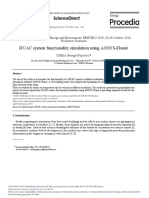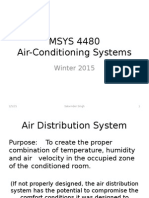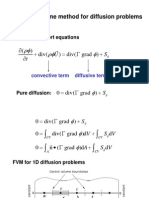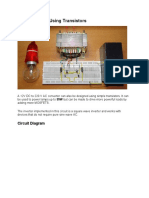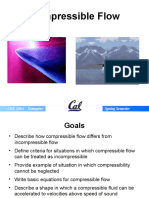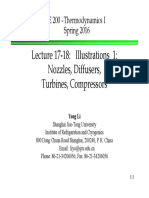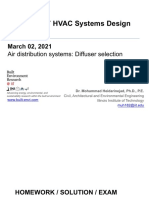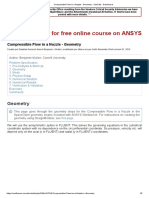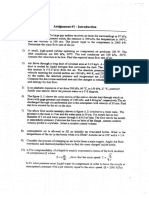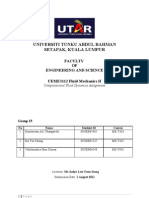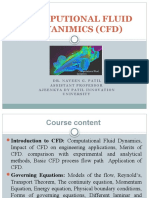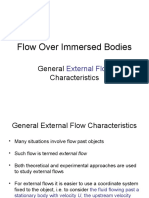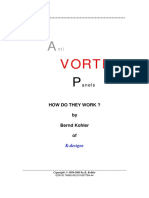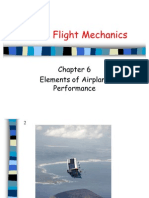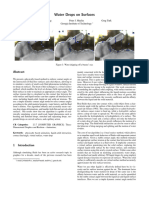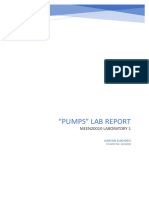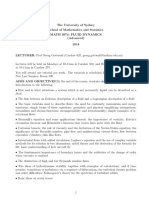ME 5337/7337
Notes-2005-002
Introduction to Computational Fluid
Dynamics
CFD Introduction
CFD 1
Ram Ramanan
05/27/16
�ME 5337/7337
Notes-2005-002
What is Computational Fluid Dynamics?
Computational Fluid Dynamics (CFD) is the science of predicting
fluid flow, heat transfer, mass transfer, chemical reactions, and related
phenomena by solving the mathematical equations which govern these
processes using a numerical process (that is, on a computer).
The result of CFD analyses is relevant engineering data used in:
conceptual studies of new designs
detailed product development
troubleshooting
redesign
CFD analysis complements testing and experimentation.
Reduces the total effort required in the laboratory.
Courtesy: Fluent, Inc
CFD 2
Ram Ramanan
05/27/16
�ME 5337/7337
Notes-2005-002
Applications
Applications of CFD are numerous!
flow and heat transfer in industrial processes (boilers, heat exchangers,
combustion equipment, pumps, blowers, piping, etc.)
aerodynamics of ground vehicles, aircraft, missiles
film coating, thermoforming in material processing applications
flow and heat transfer in propulsion and power generation systems
ventilation, heating, and cooling flows in buildings
chemical vapor deposition (CVD) for integrated circuit manufacturing
heat transfer for electronics packaging applications
and many, many more...
Courtesy: Fluent, Inc
CFD 3
Ram Ramanan
05/27/16
�ME 5337/7337
Notes-2005-002
CFD - How It Works
Analysis begins with a mathematical model
of a physical problem.
Bottle
Conservation of matter, momentum, and
energy must be satisfied throughout the
region of interest.
Fluid properties are modeled empirically.
Filling
Nozzle
Simplifying assumptions are made in order
to make the problem tractable (e.g., steadystate, incompressible, inviscid, twodimensional).
Provide appropriate initial and/or boundary
conditions for the problem.
Domain for bottle filling
problem.
Courtesy: Fluent, Inc
CFD 4
Ram Ramanan
05/27/16
�ME 5337/7337
Notes-2005-002
CFD - How It Works (2)
CFD applies numerical methods (called
discretization) to develop approximations of the
governing equations of fluid mechanics and the fluid
region to be studied.
The set of approximating equations are solved
numerically (on a computer) for the flow field
variables at each node or cell.
Governing differential equations algebraic
The collection of cells is called the grid or mesh.
System of equations are solved simultaneously to
provide solution.
The solution is post-processed to extract quantities of
interest (e.g. lift, drag, heat transfer, separation
points, pressure loss, etc.).
Courtesy: Fluent, Inc
CFD 5
Mesh for bottle filling
problem.
Ram Ramanan
05/27/16
�ME 5337/7337
Notes-2005-002
An Example: Water flow over a tube bank
Goal
compute average pressure drop, heat
transfer per tube row
Assumptions
flow is two-dimensional, laminar,
incompressible
flow approaching tube bank is steady
with a known velocity
body forces due to gravity are negligible
flow is translationally periodic (i.e.
geometry repeats itself)
Courtesy: Fluent, Inc
CFD 6
Physical System can be modeled
with repeating geometry.
Ram Ramanan
05/27/16
�How Does a CFD Code Work?
ME 5337/7337
Notes-2005-002
CFD codes are structured around the numerical algorithms that can tackle
fluid flow problems
Three main elements:
1.
2.
3.
Pre Processor
Solver
Post Processor
CFD 7
Ram Ramanan
05/27/16
�ME 5337/7337
Notes-2005-002
1) Pre-Processor
Consists of the input of
a flow problem to CFD
User Activities:
define geometry & generate grid (50%
time)
selection of phenomena to be modeled
definition of fluid properties
specification of boundary and initial
conditions
CFD 8
Ram Ramanan
05/27/16
�ME 5337/7337
Notes-2005-002
2) Solver
Three primary numerical solution techniques
finite difference, finite element, finite control volume
The numerical method performs the following:
Approximates the unknown variables by simple functions
Discretization by substitution of the approximations into the
governing flow equations and subsequent mathematical
manipulations
Solution of the algebraic equations
CFD 9
Ram Ramanan
05/27/16
�ME 5337/7337
Notes-2005-002
Solver - Finite Difference Method
Finite difference methods describe the unknowns of the flow
problems by means of point samples at the node points of a grid
co-ordinate lines
Truncated Taylor series expan-sions are used to
generate finite difference approximations of the
derivatives of in terms of point samples of at
each grid point and its immediate neighbors
CFD 10
Ram Ramanan
05/27/16
�ME 5337/7337
Notes-2005-002
3) Post Processor
Provides a user friendly (??) way to look at the results of a simulation
Domain geometry and grid display
Vector Plots
Contour Plots
Particle Tracking
CFD 11
Ram Ramanan
05/27/16
�ME 5337/7337
Notes-2005-002
Problem Solving With CFD
Results of CFD are at best as good as the physics embedded in it as at worst as
good a its operator
THESE PROBLEMS ARE COMPLEX
Prior to running a simulation there is a stage of identification and formulation
of the flow problem in terms of the physical and chemical phenomena that
need to be considered.
A successful simulation has
converged solution
grid independence
CFD 12
Ram Ramanan
05/27/16
�ME 5337/7337
Notes-2005-002
Advantages of CFD
Low Cost
Speed
Using physical experiments and tests to get essential engineering data for
design can be expensive.
Computational simulations are relatively inexpensive, and costs are likely to
decrease as computers become more powerful.
CFD simulations can be executed in a short period of time.
Quick turnaround means engineering data can be introduced early in the
design process
Ability to Simulate Real Conditions
Many flow and heat transfer processes can not be (easily) tested - e.g.
hypersonic flow at Mach 20
CFD provides the ability to theoretically simulate any physical condition
Courtesy: Fluent, Inc
CFD 13
Ram Ramanan
05/27/16
�ME 5337/7337
Notes-2005-002
Advantages of CFD (2)
Ability to Simulate Ideal Conditions
CFD allows great control over the physical process, and provides the ability to
isolate specific phenomena for study.
Example: a heat transfer process can be idealized with adiabatic, constant heat
flux, or constant temperature boundaries.
Comprehensive Information
Experiments only permit data to be
extracted at a limited number of
locations in the system (e.g. pressure
and temperature probes, heat flux
gauges, LDV, etc.)
CFD allows the analyst to examine a
large number of locations in the region
of interest, and yields a
comprehensive set of flow parameters
for examination.
Courtesy: Fluent, Inc.
CFD 14
Ram Ramanan
05/27/16
�ME 5337/7337
Notes-2005-002
Limitations of CFD
Physical Models
CFD solutions rely upon physical models of real world processes (e.g.
turbulence, compressibility, chemistry, multiphase flow, etc.).
The solutions that are obtained through CFD can only be as accurate as
the physical models on which they are based.
Numerical Errors
Solving equations on a computer invariably introduces numerical errors
Round-off error - errors due to finite word size available on the computer
Truncation error - error due to approximations in the numerical models
Round-off errors will always exist (though they should be small in most
cases)
Courtesy: Fluent, Inc
CFD 15
Ram Ramanan
05/27/16
�ME 5337/7337
Notes-2005-002
Limitations of CFD (2)
Boundary Conditions
As with physical models, the accuracy of the CFD solution is only as
good as the initial/boundary conditions provided to the numerical model.
Example: Flow in a duct with sudden expansion
If flow is supplied to domain by a pipe, you should use a fully-developed
profile for velocity rather than assume uniform conditions.
Computational
Domain
Computational
Domain
Fully Developed Inlet
Profile
Uniform Inlet
Profile
poor
Courtesy: Fluent, Inc
better
CFD 16
Ram Ramanan
05/27/16
�ME 5337/7337
Notes-2005-002
Summary
Computational Fluid Dynamics is a powerful way of modeling fluid
flow, heat transfer, and related processes for a wide range of important
scientific and engineering problems.
The cost of doing CFD has decreased dramatically in recent years, and
will continue to do so as computers become more and more powerful.
Courtesy: Fluent, Inc
CFD 17
Ram Ramanan
05/27/16





